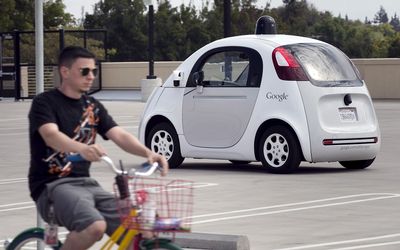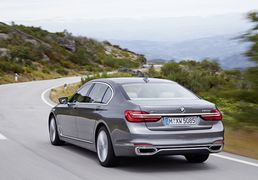Clash of man and machine awaits
by John Gapper,
2016-03-09 05:47:42.0
WHEN a Google self-driving car edged into the middle of a lane at 5km/h on St Valentine’s Day and struck the side of a passing bus, it was a scrape heard around the world. The accident, disclosed by Alphabet, Google’s parent, was the talk of the Geneva motor show last week.
I would prefer a car driven by a computer to a car driven by a human distracted by a phone.
The accident illustrates that computers and people make an imperfect combination on the roads. Robots are good at following rules, often far faster and more efficiently than people, without getting tired, distracted or drunk. But they are no better at divining how humans will behave than other humans are.
The technology for wholly autonomous cars either exists or it soon will. Most of the big motor companies believe that by 2020, they will be able to produce and sell vehicles capable of driving themselves through city streets and along multi-lane highways.
That should be a godsend. About 33,000 people are killed annually in road accidents in the US and 3.9-million people injured, with 24-million vehicles damaged. About 92% of accidents involve human error — people speeding, being distracted or not concentrating. It wouldn’t happen with computers at the controls.
Yet look around a car show and ponder what is on display to the largely male visitors. Functional vehicles, but more. Power, excitement and speed, the satisfaction of pressing a pedal and the beast obeying. One executive praised a "sharper, more masculine" redesign, another his brand’s "emotion and sportiness".
A clash of man and machine is almost upon us. Computers have beaten humans at chess. Soon, they will be better at driving. It will then be logical and safer to demote drivers to passengers ferried by robot chauffeurs.
The most striking thing is how close the car industry believes it is to making that possible. Nissan’s strategy is for its cars to take control in heavy traffic by the end of this year; to manage lane-changing and overtaking by 2018, and to master city roads by 2020.
There are still hurdles to clear before steering wheels can be removed. Autonomy requires high-definition, three-dimensional maps for cars to know where they are. They will need to communicate with others and with elements such as traffic lights.
Google’s crash would not have happened in a world fully adapted for autonomous driving. Its car calculated that the bus would stop, while the bus driver thought the car would. Google plans to program its car to "more deeply understand" the behaviour of bus drivers. Good luck with that. If human judgement were removed, and the bus and car could agree in a millisecond which had priority, transport would be more efficient. But as long as there were humans in the front seat, robots would need to keep guessing.
The main barrier to autonomy is no longer technology, but human preference and habit. Since their inception, car companies have sold cars to people who like to drive them, not be driven in them. The industry wants technology to help humans rather than take over.
The latest BMW 7 Series "tugs" on the wheel if the driver tries to change lanes as another car is approaching rapidly from behind: it drops a heavy hint rather than seizing control for safety’s sake. At heart, there is a tension between promising fulfilment and authority to drivers and developing vehicle autonomy.
Networks of self-driving cars, some hired on demand like taxis, could serve society well.
The industry needs to focus on passengers rather than drivers. Self-driving cars could be marketed on style and connectivity rather than the thrill of accelerating. Instead of people risking their lives and those of others by texting while driving, they could read, work and browse in back-seat comfort. This sounds enjoyable, and no one ever complained about having a personal chauffeur.
Financial Times

UP TO SPEED: A Google employee on a bicycle acts as a real-life obstacle for a Google self-driving prototype car to react to during a media preview of Google’s prototype autonomous vehicles in Mountain View, California, last year. Picture: REUTERS/ELIJAH NOUVELAGE
WHEN a Google self-driving car edged into the middle of a lane at 5km/h on St Valentine’s Day and struck the side of a passing bus, it was a scrape heard around the world. The accident, disclosed by Alphabet, Google’s parent, was the talk of the Geneva motor show last week.
I would prefer a car driven by a computer to a car driven by a human distracted by a phone.
The accident illustrates that computers and people make an imperfect combination on the roads. Robots are good at following rules, often far faster and more efficiently than people, without getting tired, distracted or drunk. But they are no better at divining how humans will behave than other humans are.
The technology for wholly autonomous cars either exists or it soon will. Most of the big motor companies believe that by 2020, they will be able to produce and sell vehicles capable of driving themselves through city streets and along multi-lane highways.
That should be a godsend. About 33,000 people are killed annually in road accidents in the US and 3.9-million people injured, with 24-million vehicles damaged. About 92% of accidents involve human error — people speeding, being distracted or not concentrating. It wouldn’t happen with computers at the controls.
Yet look around a car show and ponder what is on display to the largely male visitors. Functional vehicles, but more. Power, excitement and speed, the satisfaction of pressing a pedal and the beast obeying. One executive praised a "sharper, more masculine" redesign, another his brand’s "emotion and sportiness".
A clash of man and machine is almost upon us. Computers have beaten humans at chess. Soon, they will be better at driving. It will then be logical and safer to demote drivers to passengers ferried by robot chauffeurs.
The most striking thing is how close the car industry believes it is to making that possible. Nissan’s strategy is for its cars to take control in heavy traffic by the end of this year; to manage lane-changing and overtaking by 2018, and to master city roads by 2020.
There are still hurdles to clear before steering wheels can be removed. Autonomy requires high-definition, three-dimensional maps for cars to know where they are. They will need to communicate with others and with elements such as traffic lights.
Google’s crash would not have happened in a world fully adapted for autonomous driving. Its car calculated that the bus would stop, while the bus driver thought the car would. Google plans to program its car to "more deeply understand" the behaviour of bus drivers. Good luck with that. If human judgement were removed, and the bus and car could agree in a millisecond which had priority, transport would be more efficient. But as long as there were humans in the front seat, robots would need to keep guessing.
The main barrier to autonomy is no longer technology, but human preference and habit. Since their inception, car companies have sold cars to people who like to drive them, not be driven in them. The industry wants technology to help humans rather than take over.
The latest BMW 7 Series "tugs" on the wheel if the driver tries to change lanes as another car is approaching rapidly from behind: it drops a heavy hint rather than seizing control for safety’s sake. At heart, there is a tension between promising fulfilment and authority to drivers and developing vehicle autonomy.
Networks of self-driving cars, some hired on demand like taxis, could serve society well.
The industry needs to focus on passengers rather than drivers. Self-driving cars could be marketed on style and connectivity rather than the thrill of accelerating. Instead of people risking their lives and those of others by texting while driving, they could read, work and browse in back-seat comfort. This sounds enjoyable, and no one ever complained about having a personal chauffeur.
Financial Times
























Change: -0.43%
Change: -0.59%
Change: -1.86%
Change: -0.37%
Change: 0.27%
Data supplied by Profile Data
Change: -0.17%
Change: 0.21%
Change: -0.43%
Change: 0.00%
Change: 0.51%
Data supplied by Profile Data
Change: 0.04%
Change: -0.09%
Change: -0.27%
Change: 0.07%
Change: 0.00%
Data supplied by Profile Data
Change: -0.29%
Change: 0.20%
Change: 0.00%
Change: -0.35%
Change: 0.02%
Data supplied by Profile Data